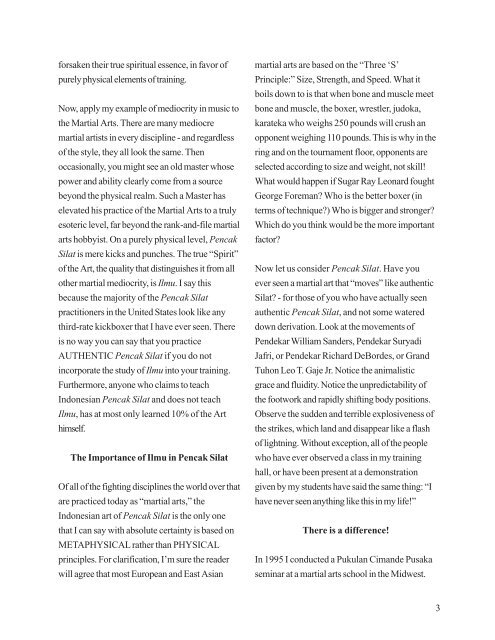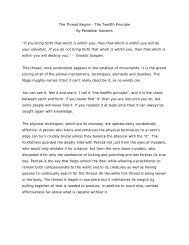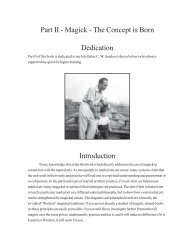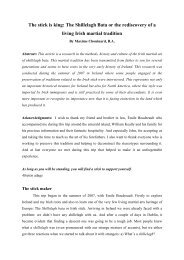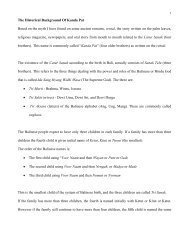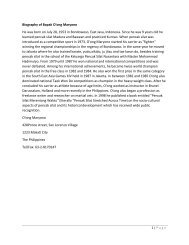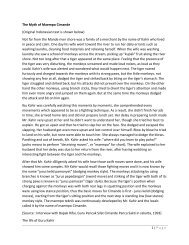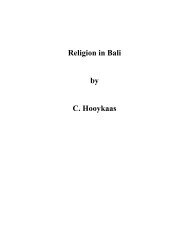Tenaga Dalam - Pukulan Cimande Pusaka
Tenaga Dalam - Pukulan Cimande Pusaka
Tenaga Dalam - Pukulan Cimande Pusaka
Create successful ePaper yourself
Turn your PDF publications into a flip-book with our unique Google optimized e-Paper software.
forsaken their true spiritual essence, in favor of<br />
purely physical elements of training.<br />
Now, apply my example of mediocrity in music to<br />
the Martial Arts. There are many mediocre<br />
martial artists in every discipline - and regardless<br />
of the style, they all look the same. Then<br />
occasionally, you might see an old master whose<br />
power and ability clearly come from a source<br />
beyond the physical realm. Such a Master has<br />
elevated his practice of the Martial Arts to a truly<br />
esoteric level, far beyond the rank-and-file martial<br />
arts hobbyist. On a purely physical level, Pencak<br />
Silat is mere kicks and punches. The true “Spirit”<br />
of the Art, the quality that distinguishes it from all<br />
other martial mediocrity, is Ilmu. I say this<br />
because the majority of the Pencak Silat<br />
practitioners in the United States look like any<br />
third-rate kickboxer that I have ever seen. There<br />
is no way you can say that you practice<br />
AUTHENTIC Pencak Silat if you do not<br />
incorporate the study of Ilmu into your training.<br />
Furthermore, anyone who claims to teach<br />
Indonesian Pencak Silat and does not teach<br />
Ilmu, has at most only learned 10% of the Art<br />
himself.<br />
The Importance of Ilmu in Pencak Silat<br />
Of all of the fighting disciplines the world over that<br />
are practiced today as “martial arts,” the<br />
Indonesian art of Pencak Silat is the only one<br />
that I can say with absolute certainty is based on<br />
METAPHYSICAL rather than PHYSICAL<br />
principles. For clarification, I’m sure the reader<br />
will agree that most European and East Asian<br />
martial arts are based on the “Three ‘S’<br />
Principle:” Size, Strength, and Speed. What it<br />
boils down to is that when bone and muscle meet<br />
bone and muscle, the boxer, wrestler, judoka,<br />
karateka who weighs 250 pounds will crush an<br />
opponent weighing 110 pounds. This is why in the<br />
ring and on the tournament floor, opponents are<br />
selected according to size and weight, not skill!<br />
What would happen if Sugar Ray Leonard fought<br />
George Foreman? Who is the better boxer (in<br />
terms of technique?) Who is bigger and stronger?<br />
Which do you think would be the more important<br />
factor?<br />
Now let us consider Pencak Silat. Have you<br />
ever seen a martial art that “moves” like authentic<br />
Silat? - for those of you who have actually seen<br />
authentic Pencak Silat, and not some watered<br />
down derivation. Look at the movements of<br />
Pendekar William Sanders, Pendekar Suryadi<br />
Jafri, or Pendekar Richard DeBordes, or Grand<br />
Tuhon Leo T. Gaje Jr. Notice the animalistic<br />
grace and fluidity. Notice the unpredictability of<br />
the footwork and rapidly shifting body positions.<br />
Observe the sudden and terrible explosiveness of<br />
the strikes, which land and disappear like a flash<br />
of lightning. Without exception, all of the people<br />
who have ever observed a class in my training<br />
hall, or have been present at a demonstration<br />
given by my students have said the same thing: “I<br />
have never seen anything like this in my life!”<br />
There is a difference!<br />
In 1995 I conducted a <strong>Pukulan</strong> <strong>Cimande</strong> <strong>Pusaka</strong><br />
seminar at a martial arts school in the Midwest.<br />
3


